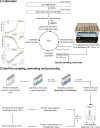Hot isopropanol quenching procedure for automated microtiter plate scale 13C-labeling experiments
- PMID: 35527247
- PMCID: PMC9082905
- DOI: 10.1186/s12934-022-01806-4
Hot isopropanol quenching procedure for automated microtiter plate scale 13C-labeling experiments
Abstract
Background: Currently, the generation of genetic diversity for microbial cell factories outpaces the screening of strain variants with omics-based phenotyping methods. Especially isotopic labeling experiments, which constitute techniques aimed at elucidating cellular phenotypes and supporting rational strain design by growing microorganisms on substrates enriched with heavy isotopes, suffer from comparably low throughput and the high cost of labeled substrates.
Results: We present a miniaturized, parallelized, and automated approach to 13C-isotopic labeling experiments by establishing and validating a hot isopropanol quenching method on a robotic platform coupled with a microbioreactor cultivation system. This allows for the first time to conduct automated labeling experiments at a microtiter plate scale in up to 48 parallel batches. A further innovation enabled by the automated quenching method is the analysis of free amino acids instead of proteinogenic ones on said microliter scale. Capitalizing on the latter point and as a proof of concept, we present an isotopically instationary labeling experiment in Corynebacterium glutamicum ATCC 13032, generating dynamic labeling data of free amino acids in the process.
Conclusions: Our results show that a robotic liquid handler is sufficiently fast to generate informative isotopically transient labeling data. Furthermore, the amount of biomass obtained from a sub-milliliter cultivation in a microbioreactor is adequate for the detection of labeling patterns of free amino acids. Combining the innovations presented in this study, isotopically stationary and instationary automated labeling experiments can be conducted, thus fulfilling the prerequisites for 13C-metabolic flux analyses in high-throughput.
Keywords: 13C-labeling; Boiling solvent quenching; Corynebacterium glutamicum; Isotopic labeling; Isotopically transient experiment; Lab automation; Metabolic quenching; Microbioreactor cultivation.
© 2022. The Author(s).
Conflict of interest statement
The authors declare no competing interests.
Figures


Similar articles
-
Analysis of 13C labeling enrichment in microbial culture applying metabolic tracer experiments using gas chromatography-combustion-isotope ratio mass spectrometry.Anal Biochem. 2008 Sep 15;380(2):202-10. doi: 10.1016/j.ab.2008.05.039. Epub 2008 Jun 17. Anal Biochem. 2008. PMID: 18565321
-
13C metabolic flux analysis for larger scale cultivation using gas chromatography-combustion-isotope ratio mass spectrometry.Metab Eng. 2010 Jul;12(4):392-400. doi: 10.1016/j.ymben.2010.02.001. Epub 2010 Feb 10. Metab Eng. 2010. PMID: 20149889
-
Stationary versus non-stationary (13)C-MFA: a comparison using a consistent dataset.J Biotechnol. 2011 Jul 10;154(2-3):179-90. doi: 10.1016/j.jbiotec.2010.07.008. Epub 2010 Jul 16. J Biotechnol. 2011. PMID: 20638432
-
13C metabolic flux analysis: optimal design of isotopic labeling experiments.Curr Opin Biotechnol. 2013 Dec;24(6):1116-21. doi: 10.1016/j.copbio.2013.02.003. Epub 2013 Feb 28. Curr Opin Biotechnol. 2013. PMID: 23453397 Review.
-
Isotopically non-stationary metabolic flux analysis: complex yet highly informative.Curr Opin Biotechnol. 2013 Dec;24(6):979-86. doi: 10.1016/j.copbio.2013.03.024. Epub 2013 Apr 24. Curr Opin Biotechnol. 2013. PMID: 23623747 Review.
Cited by
-
A High-Quality Genome-Scale Model for Rhodococcus opacus Metabolism.ACS Synth Biol. 2023 Jun 16;12(6):1632-1644. doi: 10.1021/acssynbio.2c00618. Epub 2023 May 15. ACS Synth Biol. 2023. PMID: 37186551 Free PMC article.
-
Automated in vivo enzyme engineering accelerates biocatalyst optimization.Nat Commun. 2024 Apr 24;15(1):3447. doi: 10.1038/s41467-024-46574-4. Nat Commun. 2024. PMID: 38658554 Free PMC article. Review.
References
MeSH terms
Substances
Grants and funding
LinkOut - more resources
Full Text Sources
Molecular Biology Databases
Miscellaneous

